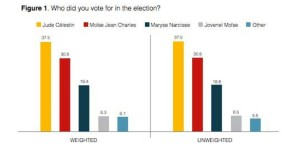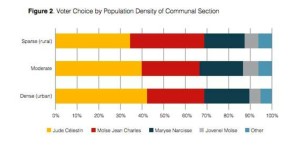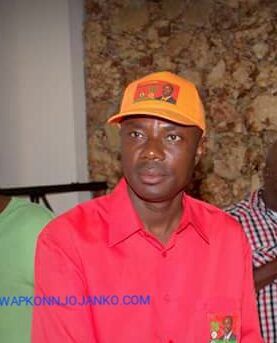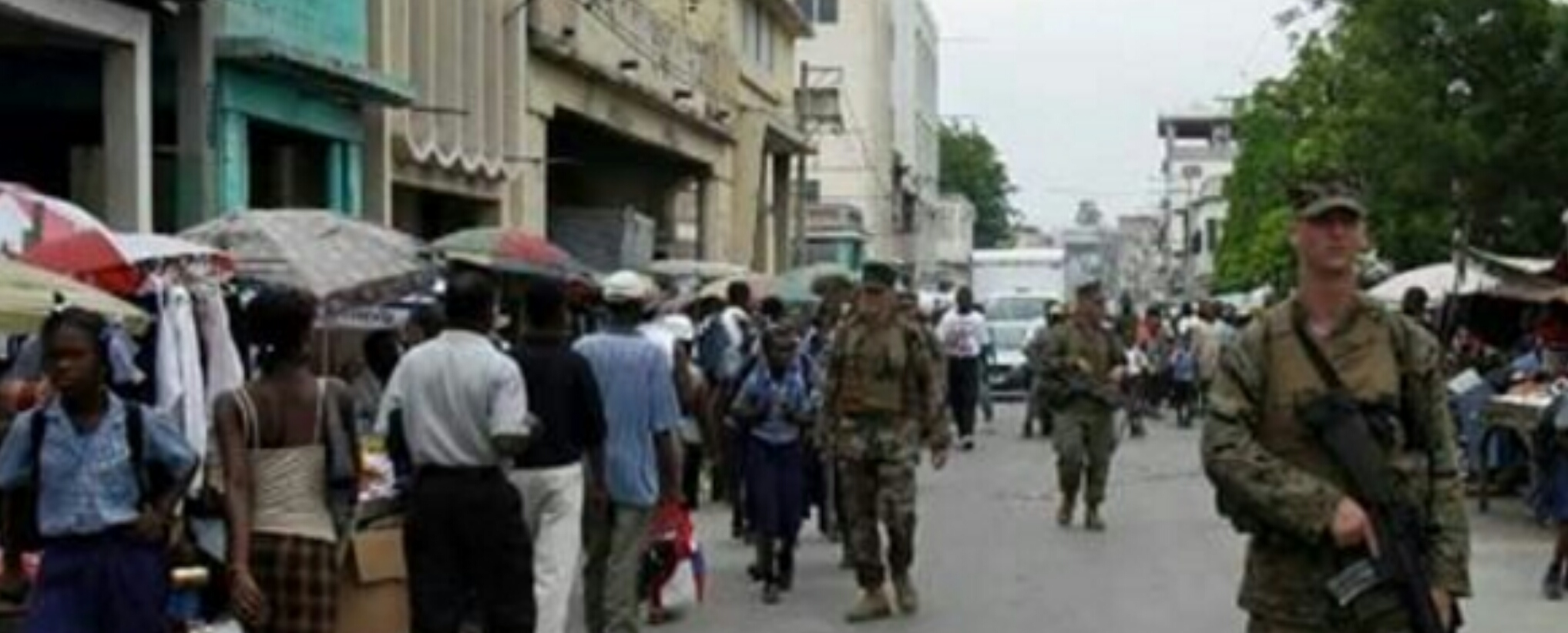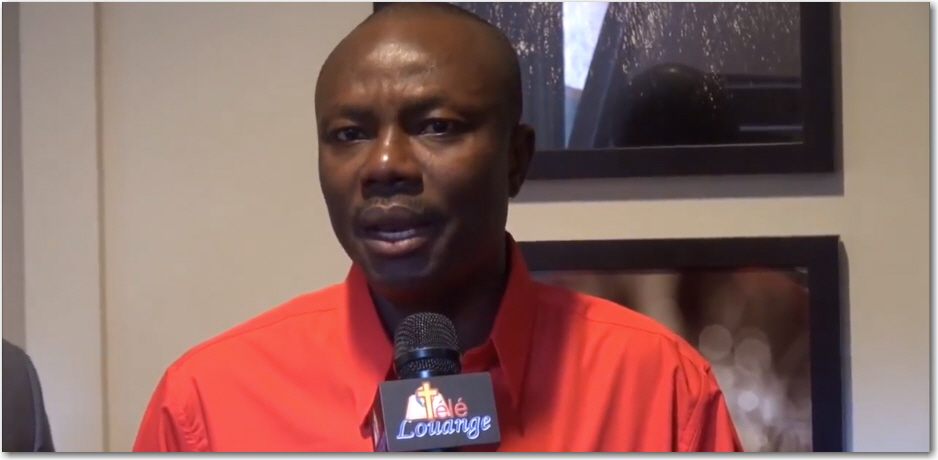Upon leaving polling stations, Haitians were asked who they voted for in the presidential election.
RIO DE JANEIRO, Brazil -An exit poll taken during the October 25, 2015 elections suggest that the top two candidates Haitians voted for president are Jude Célestin and Moïse Jean Charles. According to the percentages, the two should be facing each other in a runoff election on December 27, 2015.
Upon leaving polling stations, Haitians were asked who they voted for in the presidential election. 37.5 percent said they voted for Jude Célestin. 30.6 percent said they voted for Moïse Jean Charles. 19.4 percent voted for Maryse Narcisse and 6.3 percent for the ruling party candidate, Jovenel Moïse.
These results do not reflect what was reported by the Provisional Electoral Council (CEP) of Pierre Louis Opont. It gave Jovenel Moïse 32 percent, Célestin 24 percent, Moïse Jean Charles 14 percent and Maryse Narcisse 7.
Haiti’s presidential elections in October 2015 were reportedly marred by voting irregularities and fraud. The results issued by the Provisional Electoral Council in early November are contested, with the country again gripped by widespread protest, organized violence and targeted killings. An Igarapé Institute research team administered household surveys with voters from 135 polling stations before and after the election to assess attitudes about the electoral process. The findings suggest an incompatibility between the declared result and the voting patterns of Haitian citizens. They also indicate the corrosive effects of electoral corruption on citizen attitudes and faith in the democratic process.
On October 25, 2015, Haiti held its first round of voting for the country’s presidential election. After an August legislative election marred by flagrant violence and voter intimidation at the polls, it was not at all certain whether a presidential election would take place. In addition to voting for president, citizens were electing members of Parliament. Haiti’s parliament was dissolved last January amid a political crisis. National police made dozens of arrests of people suspected of fraud, but the violence that had marked the August elections was mostly absent in late October. The calm was short-lived. Even before the presidential election results were announced, allegations surfaced of serious fraud and irregularities in the voting process.
In order to measure whether elections were free and fair, an Igarape Institute team of American, Canadian and Haitian researchers interviewed voters at 135 polling locations across the country.The goal was to assess their experiences and attitudes about democracy and community organizing. Two days before the election results were announced, eight presidential candidates, including Jude Célestin and Moïse Jean-Charles, issued a statement alleging fraud and irregularities.
After the Provisional Electoral Council (CEP) released their tally of the election results on 5th, the capital rapidly descended into protest with mass street marches, targeted killings of political party activists, and organized violence by armed groups. Allegations of fraud continued after the CEP’s announcement with large marches protesting the alleged fraud in all of Haiti’s major cities and in many rural areas. After the CEP’s announcement of the election results, the Igarape Institute team contacted the original sample and re-interviewed 88.9% (n=1,834) of them to determine changes in attitudes about the election itself, as well as attitudes about democracy and the importance and role of voting in a democracy. Key findings from this study include:
• Nearly 40 per cent of respondents said they voted for Jude Cèlestin while roughly a third chose Moïse Jean Charles and 20 per cent chose Maryse Narcisse. Jovenel Moïse, who represented the incumbent political party and was identified by the CEP as the candidate with the most votes, was named by just 6 per cent of the voters interviewed as their choice for president.
• Candidate choice was tied to both geographic region and income with Moïse Jean Charles being most commonly chosen for President by voters in the Nord, Nord-Ouest, and Nord-Est departments and Jovenel Moïse garnering most of his support from voters whose incomes were in the highest 25% percentile
.• During interviews conducted right after voting, survey participants expressed agreement with statements about the importance of voting in a democracy. About two thirds of voters said that it was completely or somewhat true that voting determines who leads the country. Similarly, nearly three quarters of voters said it was somewhat or completely true that “my vote counts”.
• Attitudes about voting and democracy appear to be adversely affected by the experiences and perception of fraud and voter intimidation. After election results were announced, voters were significantly less likely to say that it was true that “in a democracy voting is important because it determines who leads the country”; this was correlated to both experiences of fraud and to the voter’s stated presidential choice.
• Though fraud was not as widely reported by voters on election day, intimidation of voter’s was common with nearly a third of all voters stating they completely disagreed with the statement, “Today’s election was free. There was no intimidation of voters at the polls.” Incidences of fraud were observed by research team members at 12 polling locations with the most common type of fraud being ballot box stuffing by party observers.
Timeline of Election Events in 2015
August 9 – First-round Legislative Elections, in which nearly 2,000 candidates competed for 199 seats in the Chamber of Deputies and 20 Senate seats October 25 – First-round Presidential Elections and second-round legislative elections
November 3 – Eight presidential candidates, including Jude Célestin and Moïse Jean-Charles, issued a signed letter to the Provisional Electoral Council (CEP) asking members to appoint a five-member independent commission to do a deeper scrutiny of the ballot sheets to address the allegations of fraud and irregularities prior to publishing the results.
November 5 – Provisional Electoral Counsel (CEP) announces preliminary election results showing the ruling-party’s Jovenel Moise in first place, followed by Jude Celestin and Moise Jean Charles
November 6 – Seven presidential candidates write to the CEP, again calling for an independent commission and labeling the announced results “unacceptable”
November 12 – Jaccéus Joseph, the sole member of the CEP who didn’t endorse the election results, speaks out publically for the first time, saying he couldn’t accept the results because the vote tabulation center “could have done more” to check for fraud December 27 – Proposed date for presidential runoff election
Haiti’s Election by the Numbers
54 – Presidential candidates approved by the CEP for inclusion in the October 25th election
2 – Presidential hopefuls who will be included in the December 27 runoff elections
6am – Time polling places were scheduled to be opened to voters
72 – Number of hours after the CEP announced election results during which candidates have a right to file a challenge of count with the National Electoral Complaints and Challenges Bureau (BCEN)
2 – Candidates who filed legal challenges to the elections charging widespread fraud $30 million – Amount the U.S. government gave to support the Haitian elections this year 5.8 million – Number of registered voters
15,000 – Number of policemen and United Nations peacekeeping force members deployed to prevent violence during on Election Day
1,538,393 – Number of valid votes cast in the October 25th election 120,066 – Number of votes invalidated for fraud and other irregularities
22,238 – Number of voters who choose none of the 54 candidates
490 – Number of polling locations where where votes were thrown out due to fraud
915,675 – Number of accreditation passes that were handed out to political-party monitors and observers allowing them to enter the polling place and stand next to people to observe as they voted
Methodology
A multistage process was applied to sample communal sections, households, and main respondents. The sample was drawn from all ten of Haiti’s geographic departments with representation of urban, suburban and rural areas. The most current population figures for Haiti nationally are from 2012 based on projections from the national census and published by the Institut Haitienne de Statistique et d’Informatique, or IHSI.1 These figures were used to calculate the study’s sample size. The number of individuals who would be sampled from each department was determined by population density.
A weighted random sample of communal sections was generated in SPSS. 1 See IHSI (2012). 5 IGARAPÉ INSTITUTE | STRATEGIC nOTE 20 | NOVEMBER 2015 The second phase of sampling involved the random selection of polling places within each communal section. A random GPS coordinate within the communal section was generated and a research team member was sent to the location. Residents were asked which polling place was used by residents of the location. The research team then visited the polling location and confirmed with officials that it did serve the area location randomly selected during GPS sampling. A total of 135 polling places were selected for inclusion in the study.
Findings Voter Demographics
Demographic information was collected at the beginning of each interview. Slightly more than half of all voters were female, which mirrors the general population. The average household size was 5.6 individuals (SD: 4.2) which is within the norm for Haiti. However there was some difference between the demographics of voters and the demographics of the general population. The unweighted mean age of voters was 35.88 years (SD: 10.177) which is somewhat older than the general population.5 The income of respondents was compared to the income quartiles of the general population; voters were more likely to be poor with 40.4 per cent from the lowest quartile (n=778), 20 per cent (n=771) from the second lowest quartile, 12.8 per cent (n=247) from the second highest quartile, and 6.8 per cent (n=6.4) from the highest quartile.6
When asked who they voted for in the presidential election, the results did not reflect those reported by the CEP on November 5, 2015. The CEP reported that Jovenel Moïse was the front-runner with more than a third of the vote followed by Jude Célestin. Survey respondents, however, were much more likely to state that they voted for Moïse Jean Charles or Maryse Narcisse, and less likely to vote for Jovenel Moïse, than was reflected in the numbers released by CEP (Figure 1).
Presidential choice was correlated to both income levels and geographic department. Higher income voters were more likely to choose Jovenel Moïse while lower income individuals were more likely to say they voted for Moïse Jean Charles or Maryse Narcisse. There was no statistically significant relationship between voting for Jude Célestin and either income or geographic department; he was a popular choice for voters across the socioeconomic and geographic spectrum. Moïse Jean Charles garnered most of his support from rural areas (55% of those voted for him). Though Jude Célestin was the most common presidential choice in all communal section population density types, he had an equal (weighted) per centage of the vote in rural areas when compared to Moïse Jean Charles (Figure 2).
Free and Fair Elections
Additional survey questions asked participants if the elections were free (“there was no intimidation of voters at the polls”) and/or fair (“there was no fraud”). Respondents endorsed each statement as either “completely true”, “somewhat true”, or “not at all true”. During interviews right after voting, survey respondents reported some fraud, mostly in the form of election observers and political party monitors ballot box stuffing or placing multiple votes (Figures 7 and 9). Though fraud was not as widely reported by voters on Election Day, intimidation of voter’s was common with nearly a third of all voters stating they completely disagreed with the statement “Today’s election was free. There was no intimidation of voters at the polls” (see Figure 3).
Post source : Igarapé Institute

